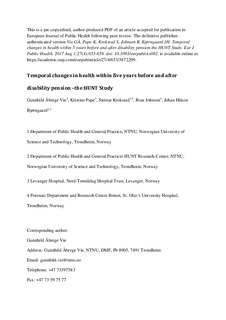| dc.contributor.author | Vie, Gunnhild Åberge | |
| dc.contributor.author | Pape, Kristine | |
| dc.contributor.author | Krokstad, Steinar | |
| dc.contributor.author | Johnsen, Roar | |
| dc.contributor.author | Bjørngaard, Johan Håkon | |
| dc.date.accessioned | 2017-12-05T10:15:48Z | |
| dc.date.available | 2017-12-05T10:15:48Z | |
| dc.date.created | 2017-09-19T14:22:34Z | |
| dc.date.issued | 2017 | |
| dc.identifier.citation | European Journal of Public Health. 2017, 27 (4), 653-659. | nb_NO |
| dc.identifier.issn | 1101-1262 | |
| dc.identifier.uri | http://hdl.handle.net/11250/2469229 | |
| dc.description.abstract | Background Health status has been reported to change before, during and after disability pension receipt. These associations might be subject to temporal changes according to changes in policy, incidence of disability pensions and other contextual factors. We compared the perceived health around time of disability retirement among persons receiving disability pension in the 1990 s and 2000 s in Norway. Methods We linked data from two consecutive cross-sectional population based Norwegian health surveys, HUNT2 (1995–97) and HUNT3 (2006–08), to national registries, identifying those who received disability pension within 5 years before or after participation in the survey (HUNT2: n = 5362, HUNT3: n = 4649). We used logistic regression to assess associations of time from receiving a disability pension with self-rated health, insomnia, depression and anxiety symptoms and subsequently estimated adjusted prevalence over time. Results Prevalence of poor self-rated health peaked around time of receiving disability pension in both decades. For those aged 50+, prevalence the year before disability pension was slightly lower in 2006–08 (74%, 95% CI 70–79%) than in 1995–97 (83%, 95% CI 79–87%), whereas peak prevalence was similar between surveys for those younger than 50. Depression symptoms peaked more pronouncedly in 1995–97 than in 2006–08, whereas prevalence of anxiety symptoms was similar at time of receiving disability pension between surveys. Conclusions We found no strong evidence of differences in health selection to disability pension in the 2000 s compared to the 1990 s. However, we found indication of less depression symptoms around time of disability pension in the 2000 s compared to the 1990 s. | nb_NO |
| dc.language.iso | eng | nb_NO |
| dc.publisher | Oxford University Press | nb_NO |
| dc.title | Temporal changes in health within 5 years before and after disability pension-the HUNT Study | nb_NO |
| dc.type | Journal article | nb_NO |
| dc.type | Peer reviewed | nb_NO |
| dc.description.version | acceptedVersion | nb_NO |
| dc.source.pagenumber | 653-659 | nb_NO |
| dc.source.volume | 27 | nb_NO |
| dc.source.journal | European Journal of Public Health | nb_NO |
| dc.source.issue | 4 | nb_NO |
| dc.identifier.doi | 10.1093/eurpub/ckx082 | |
| dc.identifier.cristin | 1495441 | |
| dc.description.localcode | © The Author 2017. Published by Oxford University Press on behalf of the European Public Health Association. All rights reserved. This is a pre-copyedited, author-produced PDF of the article accepted for publication following peer review, locked until 20 December 2017 due to copyright restrictions. The version of record is available online at: http://dx.doi.org/10.1093/eurpub/ckx082. | nb_NO |
| cristin.unitcode | 194,65,20,0 | |
| cristin.unitcode | 194,65,20,15 | |
| cristin.unitname | Institutt for samfunnsmedisin og sykepleie | |
| cristin.unitname | Helseundersøkelsen i Nord-Trøndelag | |
| cristin.ispublished | true | |
| cristin.fulltext | postprint | |
| cristin.fulltext | preprint | |
| cristin.qualitycode | 1 | |
